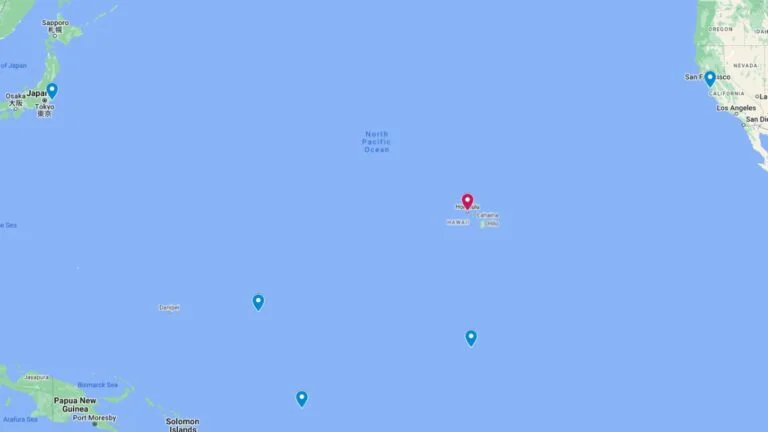Please Note: This Flight Involves a Date Change – Here’s What It Means

As participants in Amazon Associates and other programs, we earn from qualifying purchases. This comes at no additional cost to you. For more details, see our Affiliate Disclosure.
Traveling is an adventure filled with excitement, new experiences, and occasionally, a little bit of time-travel. If you’ve ever been on a long-haul flight or one that crosses multiple time zones, you may have encountered a curious phenomenon: arriving at your destination on a different day than when you departed. In this article, we’ll delve into why certain flights involve a date change and provide you with key insights on what this means for your journey.
HIGHLIGHTS
- Travel involving a date change requires meticulous planning and understanding, especially for long-haul flights that cross the International Date Line.
- Proper accommodation, transport planning, and medication schedules are vital to ensure a seamless journey.
- Advanced flight scheduling software assists airlines in handling the complexities of date changes, ensuring minimal disruption for travelers.
- Embracing flexibility and staying informed about local customs and events are key for travelers to adapt and enjoy their journey.
What Does Please Note: This Flight Involves a Date Change Mean?
“Please Note: This Flight Involves a Date Change” is a warning commonly issued by airlines or travel agents to indicate that, during the course of a flight, passengers will experience a change in the date due to crossing multiple time zones or the International Date Line.
Essentially, this means that you might depart on one date and, because of the route taken by your flight and the time zones crossed, arrive on either the previous or the subsequent day at your destination.
Our planet is segmented into 24 time zones, each symbolizing an hour of the day. As a result, as one travels east or west, the local time will adjust either forwards or backwards.
The most dramatic of these shifts occurs at the International Date Line, which largely follows the 180° longitude line in the Pacific Ocean. When you cross this line heading westward, you’ll effectively “skip” a day forward, while crossing eastward means you’ll “rewind” and relive the previous day. This can lead to situations where travelers land a day before they took off or seemingly “lose” a day of their trip.
Being aware of this change is vital for accurate hotel bookings, scheduling activities, taking time-sensitive medications, and understanding the validity dates on travel-related documents.
Understanding Time Zones and the International Date Line
Our planet is a vast, spinning sphere, and as it rotates on its axis, different parts of the world experience daylight and darkness. This rotation is the primary reason we have day and night. However, given the Earth’s size and the need for a standardized concept of time, the world is divided into time zones. Let’s break down the nuances of time zones and the special role of the International Date Line.
Time Zones
- Basics: A time zone is a region of the globe that observes the same standard time. The concept was established to aid travel and communication across countries and continents that experience different times of the day due to the Earth’s rotation.
- Division: The Earth takes approximately 24 hours to complete one rotation, leading to the creation of 24 standard time zones. Each time zone represents one hour of time.
- Longitude and Time: The prime meridian in Greenwich, England, set at 0° longitude, is the starting point. As you move east or west from this line, every 15° of longitude represents a one-hour difference in time.
- Daylight Saving Time (DST): Some regions adjust their clocks for daylight saving time, shifting the clock forward in the spring and back in the fall. This practice can momentarily change the time zone differences between certain locations.
The International Date Line (IDL)
- Location: The IDL is an imaginary line located mostly along the 180° longitude in the middle of the Pacific Ocean, opposite the prime meridian. However, it deviates around certain territories and islands.
- Function: The IDL serves as the “reset” point for the calendar. When you cross the IDL heading westward, you add a day, and when you cross it heading eastward, you subtract a day.
- Anomalies: Due to the political and economic ties of certain countries, the IDL zigzags around some territories to avoid splitting a country into two different days.
Understanding time zones and the IDL is crucial for international travel, global business, and a myriad of daily activities in our interconnected world. It ensures synchrony in a world that never sleeps, where the sun is always rising somewhere and setting elsewhere.
The Science Behind the Date Change on Flights
Flight schedules, especially those on long-haul routes, occasionally surprise travelers with the phenomenon of date change. At its core, this isn’t a matter of witchcraft or time travel, but rather the outcome of Earth’s rotation, the division of the world into time zones, and the existence of the International Date Line. Delving into the science behind these factors illuminates the reasons why one might depart on a Friday in one country and arrive on a Sunday in another.
Earth’s Rotation and Time Zones
- Foundational Concept: The Earth rotates once approximately every 24 hours, which brings about the cycle of day and night. Because of this, and to standardize the chaos that different local times could create, the world was divided into 24 time zones, each theoretically representing one hour of Earth’s rotation.
- Longitude and Time: Earth’s longitudinal lines, which run from the North to the South Pole, play a vital role in this division. Starting from the Prime Meridian in Greenwich (0° longitude), every 15° represents a time change of one hour as you move east or west. Therefore, during a flight, as you traverse these longitudinal lines, local time changes accordingly.
The International Date Line (IDL) and the Jump
- What is the IDL? The IDL is an imaginary line that primarily sits at the 180° longitudinal mark, opposite the Prime Meridian. However, it isn’t a straight line, as it deviates to accommodate political borders and territories.
- The Calendar Leap: When a flight crosses the IDL, the date suddenly jumps forward a day (if moving westward) or goes back a day (if moving eastward). This “time jump” isn’t about traveling time but is a convention to keep the entire world on a synchronized 24-hour cycle, despite the vast differences in local solar times.
Flight Trajectories and Speed
- Direction and Duration: The trajectory of the flight and its duration can make a significant difference. For example, a direct flight from Los Angeles to Tokyo might cross the IDL, resulting in a date change, whereas a longer, more circuitous route may avoid it.
- Relative Speed: While the speed of the airplane remains constant, the rotational speed of the Earth means that flights traveling eastward are, in a way, “chasing” the sunrise, which can prolong the experience of a single day. Conversely, westward flights might seem to “outrun” the sunset, thereby shortening the day.
The science behind date changes on flights is a beautiful interplay of human conventions like time zones and the natural rotation of our Earth. While it can be initially disorienting, understanding the mechanics provides travelers with a richer appreciation of the complexities of our world and the skies above.
How Airlines Plan and Schedule Flights with Date Changes
The intricate task of flight scheduling is akin to a grand symphony, where countless pieces must harmoniously fit together. This becomes even more complex when considering international routes that cross multiple time zones or the International Date Line (IDL). So, how do airlines ensure that flights involving a date change are scheduled efficiently, keeping both operational and passenger needs in mind? Let’s take a closer look.
Understanding Passenger Needs and Expectations
- Clear Communication: Passengers need to be aware of date changes to plan their journeys effectively, especially for connecting flights, hotel bookings, and other time-sensitive commitments. Airlines, therefore, explicitly mention the date of arrival in flight details to avoid confusion.
- Optimal Timing: Airlines aim to schedule flights at times that are convenient for passengers. For instance, long-haul flights are often overnight to allow travelers to sleep onboard and arrive in the morning, potentially helping to combat jet lag.
Operational Considerations
- Aircraft Utilization: To maximize efficiency and profitability, airlines need to ensure their aircraft are flying as often as feasible. When scheduling, they consider turnaround times (the time an aircraft remains at the gate), maintenance needs, and the effects of date changes on these factors.
- Crew Scheduling: Crew members, especially pilots and cabin crew, are subject to strict regulations regarding working hours and rest periods. When there’s a date change involved, airlines must factor in potential extended duty periods or layovers in scheduling to ensure compliance.
- Ground Operations: Scheduling also has to accommodate the availability of gates, ground services, and baggage handling, especially at busy international airports. The date change might mean the difference between arriving during a busy hub’s peak time or a quieter period, affecting resource allocation.
Navigational and Regulatory Compliance
- Air Traffic Rights: Airlines must abide by air traffic rights and agreements between countries. Some routes might be restricted or only allowed on specific days, which can play into how flights are scheduled.
- Optimal Routes: While the shortest path between two points might cross the IDL, airlines sometimes adjust routes based on prevailing winds, weather conditions, and airspace restrictions. These adjustments can affect whether a flight experiences a date change or not.
The Role of Advanced Technology
- Sophisticated Software: Modern airlines utilize advanced flight scheduling software, which considers a vast array of variables, including date changes, to optimize flight schedules.
- Real-time Adjustments: Modern systems allow airlines to make real-time adjustments to deal with unexpected situations, ensuring minimal disruption even when there’s a date change involved.
Planning and scheduling flights with date changes is a multifaceted task that necessitates a delicate balance between operational needs, regulatory compliance, and passenger comfort. With the aid of technology and meticulous planning, airlines navigate these complexities to provide seamless experiences for travelers.
Preparing for Your Journey: Tips to Adjust and Plan Accordingly
Setting off on a journey that involves a date change can be exhilarating, but without adequate preparation, it can also introduce complications. A leap forward or rewind in time might be exciting in movies, but in real life, it demands a touch of foresight. Here’s how you can be a step ahead and ensure your travels are as smooth as possible.
1. Understand Your Itinerary:
- Check Arrival Date: Before you confirm your booking, double-check the arrival date, especially for long-haul flights. This will help you set clear expectations and avoid surprises or potential conflicts in your schedule.
- Account for Layovers: Consider the duration and location of layovers. If you’re connecting through a different time zone or crossing the IDL, factor this into your overall travel time.
2. Accommodation and Transport Planning:
- Align Hotel Check-ins: Ensure that your hotel booking aligns with your updated arrival date. For instance, if you’re arriving a day later than your departure date due to crossing the IDL, your accommodation should be ready for you.
- Organize Ground Transport: If you’re renting a car or using a shuttle service, ensure they are aware of the correct pickup date and time.
3. Medications and Health:
- Medication Schedule: If you’re on time-sensitive medication, plan the doses keeping the date change in mind. A discussion with a healthcare professional can provide guidance on this.
- Combat Jet Lag: A date change often means you’ve traveled through multiple time zones. Adjusting your sleep schedule a few days before departure, staying hydrated, and avoiding alcohol and caffeine can help mitigate the effects of jet lag.
4. Digital Assistance:
- Set Multiple Clocks: Use your smartphone or digital watch to keep track of both your home time zone and your destination’s. Apps like World Clock can be handy.
- Travel Apps: Use travel apps that automatically adjust your itinerary based on the local time zone. This includes flight trackers, hotel bookings, and activity schedules.
5. Financial and Legal Preparations:
- Valid Documents: Ensure that your travel documents, such as visas, remain valid for the adjusted dates of arrival and departure.
- Notify Financial Institutions: If you’re traveling internationally and crossing dates, alert your bank or credit card company of your travel plans to avoid any unexpected account freezes due to “suspicious” foreign transactions.
6. Mental Preparation:
- Embrace Flexibility: Understand that traveling across time zones and dates can be disorienting. Adopt a flexible mindset, anticipate potential challenges, and give yourself grace to adapt.
- Stay Informed: Familiarize yourself with the local customs, activities, and significant events of your destination. If you’re arriving a day later, you might be landing on a local holiday or during a major event.
Preparing for a journey involving a date change might require an extra layer of planning, but with these tips in hand, you can set the stage for a memorable and hassle-free adventure. Safe travels!






